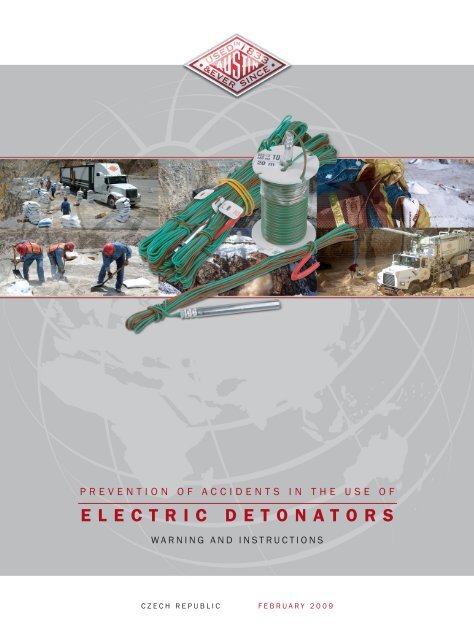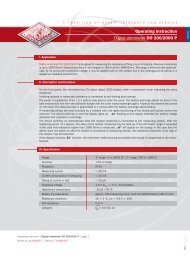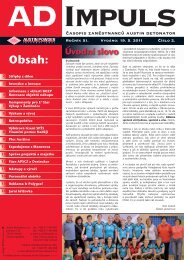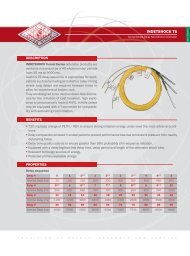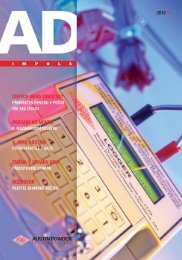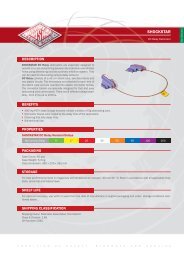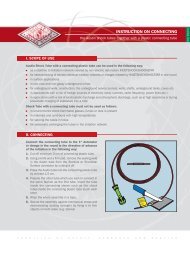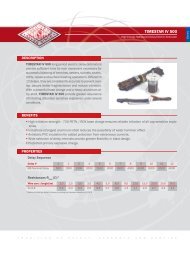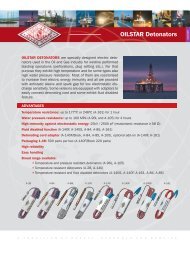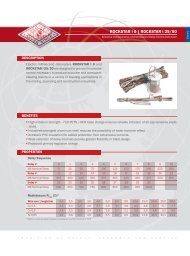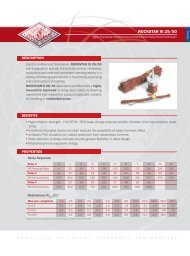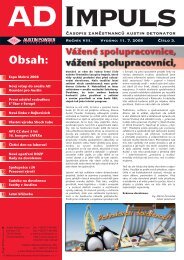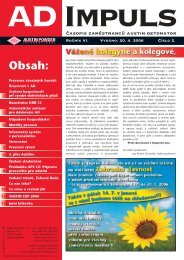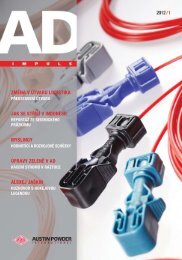User's Guide - Austin Detonator sro
User's Guide - Austin Detonator sro
User's Guide - Austin Detonator sro
Create successful ePaper yourself
Turn your PDF publications into a flip-book with our unique Google optimized e-Paper software.
P R E V E N T I O N O F A C C I D E N T S I N T H E U S E O F<br />
E L E C T R I C D E T O N A T O R S<br />
W A R N I N G A N D I N S T R U C T I O N S<br />
C Z E C H R E P U B L I C F E B R U A R Y 2 0 0 9
WARNINGS AND INSTRUCTIONS<br />
All explosive materials are dangerous and must be carefully handled and used following approved safety procedures either by or under<br />
the direction of competent, trained, and experienced persons, and in accordance with applicable state and local laws, regulations and<br />
ordinances. If, after carefully reading this entire leaflet, you have any questions or doubts as to how to use any explosive product, do not<br />
use it before consulting your supervisor, or <strong>Austin</strong> <strong>Detonator</strong>. If your supervisor has any questions or doubts, he should consult <strong>Austin</strong><br />
<strong>Detonator</strong> before use.<br />
READ AND HEED THESE WARNING AND INSTRUCTIONS<br />
Storing and transporting electric detonators<br />
General<br />
•<br />
Always separate magazine from other magazines, buildings where<br />
persons might dwell, highways, and passenger railways.<br />
Be sure magazines are securely locked, and protected from<br />
weather, fire and theft.<br />
Keep the inside of the magazine clean, dry, cool and well<br />
ventilated.<br />
Always follow state and local laws and regulations concerning<br />
transportation.<br />
Use care when loading and unloading detonators.<br />
When transporting the detonators using motor vehicles, transport<br />
the detonators in their original packing.<br />
Transport only the required amount of explosives and detonators<br />
to the blast area.<br />
Always rotate stocks of explosive material so the oldest material<br />
in the magazine is used first.<br />
Keep explosives and detonators separate until the last possible<br />
moment.<br />
Never allow lighters, matches, open flame or other sources of<br />
ignition within 15 meters of the magazine.<br />
Don’t store detonators with other explosive material.<br />
Never exceed recommended storage quantity, time and temperature<br />
for detonators.<br />
<strong>Detonator</strong> must be stored in the environment with relative humidity<br />
not exceeding 80% and temperatures between -30°C<br />
and +40°C.<br />
Do not leave a vehicle containing detonators unattended.<br />
•<br />
•<br />
•<br />
•<br />
•<br />
•<br />
•<br />
•<br />
•<br />
•<br />
•<br />
•<br />
•<br />
Shipping classification<br />
<strong>Detonator</strong>s are classified for shipment as Class 1, Division 4B<br />
and 4S, UN number 0255 and 0456. The classification is for<br />
railway, sea, road, and air transportation as per RID, ADR, ADN,<br />
IMDG-CODE and IATA-DGR.<br />
Marks and packaging<br />
<strong>Detonator</strong>s are shipped in fibreboard cases, one box contains 5<br />
or 10 inner boxes, depending on the size of case. <strong>Detonator</strong>s are<br />
packed in inner boxes, each containing maximum of 100 Pcs (2<br />
m leg wires length detonators). Quantity of detonators depends on<br />
the length of leg wires. Cases are marked with labels carrying the<br />
product identification, ID number and Class and Division Code.<br />
Shelf life and warranty<br />
<strong>Detonator</strong>s shelf life is 24 months from the date of manufacture<br />
provided they are stored in the environment with temperatures<br />
between -30°C and +40°C. Warranty period is 24 months from<br />
the date of shipment.<br />
Handling electric detonators<br />
General<br />
•<br />
•<br />
•<br />
•<br />
Keep explosive materials away from children, unauthorized<br />
persons and livestock.<br />
Carry out the blasts under the supervision of a shotfirer.<br />
The shotfirer is responsible for firing the round.<br />
Don’t allow any lighters, matches, open flame or other sources<br />
of ignition in the blasting area.<br />
Always use permissible detonators (COALSTAR and/or TIMESTAR<br />
Cu shell execution) in flammable, gassy, or dusty environments,<br />
wherever required by applicable local laws and regulation.<br />
Never split the detonator open or use any other method to<br />
dissect and examine the inside of the detonator.<br />
•<br />
•<br />
Application and use of Electric <strong>Detonator</strong>s<br />
ROCKSTAR, TIMESTAR, SEISMICSTAR detonators can be used<br />
in the following:<br />
• Open-pit mines.<br />
• Non-gassy, non-coal underground mines.<br />
• Gassy coal mines for coal and rock quarry (TIMESTAR Cu shell<br />
execution only).<br />
• Underground construction and lots not intended for use in<br />
underground coal mining (for example: tunnels, shafts, wells,<br />
underground containers, underground redevelopment construction,<br />
caves).<br />
ROCKSTAR, TIMESTAR, SEISMICSTAR detonators may not be<br />
used in the following:<br />
• Environments with explosive gasses, fumes, or dust where no<br />
concentration limit for the explosive gasses has been determined<br />
for blasting work. The fumes, gasses, or dust contained in<br />
a given environment are not considered explosive provided they<br />
do not reach the concentration needed for their initiation.<br />
• Materials in which use of detonators may cause fire or explosion.
COALSTAR detonators can be used in the following:<br />
• Open-pit mines.<br />
• Non-gassy mines.<br />
• Gassy coal mines for coal and rock quarry in the environments<br />
where concentration limit of methane or coal dust is determined<br />
by local regulation.<br />
• Underground construction and lots not intended for use in<br />
underground coal mining (for example: tunnels, shafts, wells,<br />
underground containers, underground redevelopment construction,<br />
caves).<br />
COALSTAR detonators may not be used in the following:<br />
• Materials in which use of detonators may cause fire or explosion.<br />
Preparing the Electric Blasting Circuit<br />
• For a given blasting work, always use detonators of a single<br />
electrical sensitivity produced by singe manufacturer.<br />
• Make sure that all leg wire ends are clean before connecting.<br />
• For the connections in the shotfiring circuit use connecting<br />
sleeves.<br />
• Keep the firing circuit completely insulated from ground or other<br />
conductors.<br />
• Hook up the round only after all unnecessary equipment has<br />
been removed.<br />
• For checking the circuit values use only instruments approved<br />
for use at the blast site.<br />
• The measured resistance of the firing circuit must correspond to<br />
the value calculated on the basis of the quantities and types of<br />
detonators used in a given blasting circuit.<br />
• Prior every use, test the shot firing cable for continuity and possible<br />
short circuit.<br />
• Regularly test blasting machine as well as the testing equipment<br />
for correct performance.<br />
• Attach detonator to detonating cord with tape or any other method<br />
recommended by manufacturer of the detonating cord.<br />
• Point the detonators in the direction of detonation.<br />
• Don’t attach the detonator for initiating the blast to the detonating<br />
cord until the blasting area has been cleared and secured for<br />
the blast.<br />
• Never attach exploder with shotfiring cable until you are ready<br />
to fire the blast.<br />
• Never make the final hook up to power source until all personnel<br />
are clear of the blast area.<br />
• Don’t bring or leave detonators near an open fire or hot stove.<br />
Initiation<br />
<strong>Detonator</strong>s may be initiated only with approved blasting machine<br />
supplying energy of no less than:<br />
• 3 mJ/Ω (group I detonators, No fire current 0,18 A)<br />
• 16 mJ/Ω (group II detonators, No fire current 0,45 A)<br />
• 140 mJ/Ω (group III detonators, No fire current 1,2 A)<br />
• 2,5 J/Ω (group VI detonators, No fire current 4 A)<br />
COALSTAR detonator in methan or coal dust environment should<br />
be initiated with special blasting machine with the time limitation<br />
current max. 4 ms.<br />
Water resistance<br />
<strong>Detonator</strong>s can be used in wet condition.<br />
Electric detonators ROCKSTAR, TIMESTAR and COALSTAR may<br />
not be exposed to water for more than 24 hours, the water pressure<br />
not exceeding 0.3 Mpa.<br />
Electric detonators SEISMICSTAR may not be exposed to water for<br />
more than 6 months, the water pressure not exceeding 1 Mpa.<br />
Temperature range<br />
Electric detonators ROCKSTAR, TIMESTAR and COALSTAR can<br />
be used in temperatures between -30°C and +60°C,<br />
Electric detonators SEISMICSTAR can be used in temperatures<br />
between -30°C and +80°C.<br />
Protecting against foreign sources of electricity<br />
• Never fire a blast above ground during a thunderstorm.<br />
• Always check for stray currents.<br />
• Never handle or use electric detonators:<br />
• when stray currents are present<br />
• during electrical storms<br />
• if static electricity is present<br />
• Never load boreholes in open-pit sites near electric power lines<br />
• Don’t use “I” and “II” electric detonators for blasting near H.T.<br />
lines and electric railways, near the RF sources. For this application<br />
always use “IV” detonators, if it is allowed by applicable<br />
local laws and regulation.<br />
Making of primers with detonators<br />
General<br />
• Assemble the primer carefully, regardless of the initiating<br />
method used. Primers should be assembled at the working<br />
place immediately prior loading.<br />
• Use a minimum of force for preparing the primers. Where<br />
necessary, holes should be pre-formed in the cartridge to<br />
allow easy insertion of the detonator.<br />
• Place the detonator in the center, with the base inserted in<br />
the explosive. Wherever possible, the complete length of the<br />
detonator should be inside the primer.<br />
• Do not subject the leg wires to an unnecessarily heavy pull; extensive<br />
force may break the leg wires or damage the insulation.<br />
Small diameter cartridges<br />
• punch a hole straight into one end of the cartridge<br />
• insert the detonator into the hole<br />
• tie leg wires around the cartridge using a half-hitch<br />
• never subject the leg wires to an unnecessarily heavy pull; extensive<br />
force may break the leg wires or damage the insulation.<br />
Large diameter cartridges<br />
• punch a slanting hole starting at the center of one end of the
cartridge leading to the side, two or more inches from the end<br />
• fold over the leg wires about 12 inches from the detonator to<br />
form a sharp bend<br />
• push the folded wires through the hole starting at the end of the<br />
cartridge and coming out through the side<br />
• unfold the wires and pass the loop over the other end of the<br />
cartridge<br />
• punch another hole straight into the end of the cartridge beside<br />
the first, insert the detonators in this hole and take up all the<br />
slack in the wires<br />
Cast boosters<br />
• always follow the manufacture’s recommendations for the<br />
attachment and use of detonators with cast or manufactured<br />
boosters<br />
Side priming method<br />
• Punch a hole in the side of cartridge. Make the hole deeper<br />
than length of the detonator pointing downward rather than<br />
across the cartridge.<br />
• Insert detonator.<br />
• Tape wires to the cartridge to prevent the detonator from being<br />
pulled out of the cartridge.<br />
Reverse primer method<br />
• Punch a hole straight into one end of the cartridge. Make the<br />
hole deeper than length of detonator<br />
Delay stages specification<br />
ROCKSTAR<br />
COALSTAR<br />
Firing parameters<br />
Type “I”<br />
Type “II“<br />
Type “III“<br />
Delay stages 1 through 20 - step 25 ms<br />
Delay stages 21 through 30 - step 50 ms<br />
Delay stages 1 through 16 - step 30 ms<br />
Fusehead resistance<br />
No fire current<br />
No fire impulse<br />
Electric strength<br />
Flash-over voltage<br />
All fire impulse in series<br />
Fusehead resistance<br />
No fire current<br />
No fire impulse<br />
Electric strength<br />
Flash-over voltage<br />
All fire impulse in series<br />
Fusehead resistance<br />
No fire current<br />
No fire impulse<br />
Electric strength<br />
Flash-over voltage<br />
All fire impulse in series<br />
•<br />
•<br />
Insert detonator.<br />
Fold back the wires over the end so that it lies along the length<br />
of the cartridge.<br />
Tape wires to the cartridge.<br />
•<br />
Misfires<br />
• Wait at least 15 minutes with misfires before returning to the<br />
blast area. Follow local regulation.<br />
• Don’t drill, bore or take out any explosive material that has<br />
been misfired.<br />
• Misfires should be handled by a trained, competent and experienced<br />
person familiar with the blast design, including the<br />
location and type of all explosive material used.<br />
• Always shunt the naked leg wires of a misfired electric detonator<br />
by twisting them together and taping them to the metal<br />
shell to protect against foreign sources of electrical energy.<br />
Disposal of detonators<br />
• Always handle defective or damaged detonators with special care.<br />
• Defective or damaged detonators present a greater hazard than<br />
explosive material in good condition.<br />
• Always dispose of detonators using proper methods. Consult<br />
your supervisor or <strong>Austin</strong> <strong>Detonator</strong>.<br />
• Expired, defective or damaged detonators shall be destroyed<br />
by explosion.<br />
• Forward the packaging material and leg wires remains for secondary<br />
conversion.<br />
MECHANICAL AND FUNCTIONAL PARAMETERS<br />
1,7±0,2 Ω<br />
0,18 A<br />
0,8 mJ/Ω<br />
5 kV<br />
1,5 - 6 kV<br />
3 mJ/Ω<br />
0,56±0,04 Ω<br />
0,45 A<br />
8 mJ/Ω<br />
5 kV<br />
1,5 - 6 kV<br />
16 mJ/Ω<br />
0,18±0,02 Ω<br />
1,2 A<br />
80 mJ/Ω<br />
5 kV<br />
1,5 - 6 kV<br />
140 mJ/Ω<br />
TIMESTAR 250<br />
TIMESTAR 500<br />
Type “Ia”<br />
Type “IIa“<br />
Type “IV“<br />
Delay stages 1 through 21 (1-18, 20, 22,<br />
24) - step 250 ms<br />
Delay stages 1 through 12 - step 500 ms<br />
Fusehead resistance<br />
No fire current<br />
No fire impulse<br />
Electric strength<br />
Flash-over voltage<br />
All fire impulse in series<br />
(t z<br />
=1,8 ms)<br />
Fusehead resistance<br />
No fire current<br />
No fire impulse<br />
Electric strength<br />
Flash-over voltage<br />
All fire impulse in series<br />
Fusehead resistance<br />
No fire current<br />
No fire impulse<br />
Electric strength<br />
Flash-over voltage<br />
All fire impulse in series<br />
1,4±0,1 Ω<br />
0,20 A<br />
1,2 mJ/Ω<br />
5 kV<br />
1,5 - 6 kV<br />
2mJ/Ω<br />
(I z<br />
=0,8 A)<br />
0,22±0,02 Ω<br />
1 A<br />
25 mJ/Ω<br />
5 kV<br />
1,5 - 6 kV<br />
50 mJ/Ω<br />
0,036±0,004 Ω<br />
4 A<br />
1,1 J/Ω<br />
5 kV<br />
1,5 - 6 kV<br />
2,5 J/Ω<br />
Disclaimer of Warranties and Limitations of Liabilities<br />
Product described in this bulletin are sold by <strong>Austin</strong> <strong>Detonator</strong> s.r.o. without warranty; express implied or statutory or as to MERCHANTABILITY, except as expressly stated in <strong>Austin</strong> <strong>Detonator</strong> straight bill of lading. Under<br />
no circumstances shall seller be liable for loss of anticipated profits, consequential or incidental damages.<br />
The product described may be subject to change.<br />
For more information and service locations in your area, please contact:<br />
<strong>Austin</strong> <strong>Detonator</strong><br />
Phone: +420-571-404-001<br />
Jasenice 712<br />
Fax: +420-571-404-002<br />
755 01 Vsetín<br />
Web: www.austin.cz<br />
Czech Republic<br />
e-mail: marketing.info@austin.cz<br />
© <strong>Austin</strong> <strong>Detonator</strong> | v. 221113


